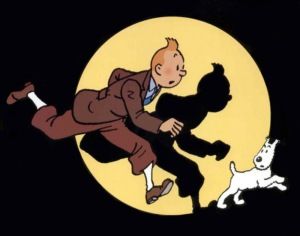Business & Education
Blistering barnacles! Tintin was a Dane
This article is more than 9 years old.
Veteran actor Palle Huld’s most famous role is one he has never received proper credit for

Unlike Tintin, Huld was so young he was frightened of his own shadow, and he didn’t even have a dog (photo: Wikipedia)
Tintin is dead. But before children across Europe begin weeping hysterically, perhaps a clarification is in order. The beloved cartoon character is still alive and well – he and his faithful dog Snowy are undoubtedly pursuing a new adventure as we speak – but the man who many believe inspired the series, Danish actor Palle Huld, passed away in November 2010 at the age of 98.
Tintin: The Boy
Huld’s life didn’t begin as one destined to be immortalised in one of the most popular cartoons of all time. Born in Hellerup in August 1912, he was the son of a grain merchant and a housewife. As a young boy, he apprenticed as a milliner and then as a warehouse assistant at F Bülow & Co. On a cold February morning in 1928, what began as a normal shift at the automobile firm became a day that would change his life forever.
That morning, one of Huld’s colleagues burst into the warehouse excitedly waving a copy of Politiken newspaper. The paper was calling for a 15-year-old boy to travel the world to recreate Phileas Fogg’s fictional adventures in ‘Around the World in 80 Days’. Dreamt up as a way to pay tribute to what would have been author Jules Verne’s 100th birthday (the author died in 1905), Politiken wanted to demonstrate that with the modern technology of the time it would be possible to circumnavigate the globe in almost half the time of Fogg’s epic tale. Specifically, the advertised journey was to take just 44 days, and without the use of aircraft.
Huld was instantly struck by the idea. “Something in me had to try it,” he wrote in his 1992 autobiography. He took leave from work and, after a quick stop home to secure the required parental permission slip, hightailed it off to Rådhuspladsen to make the 2pm deadline. There, he was greeted by 300-400 other wanderlust-struck boys who had shown up for the contest. He waited his turn to interview and then returned home to the teasing of his sisters, who felt that “mummy’s boy Palle” would surely not be chosen. However, much to Palle’s pleasure and the disconcertion of his sisters, he returned to the Politiken office later in the day to receive the news that he had won the coveted spot.
Tintin: The Adventurer
On 1 March 1928 – just one week after first seeing the Politiken ad – Huld boarded a train in Copenhagen and set off on his journey to the adulation of Dannebrog-waving fans. He crossed Denmark by train, sailed to England and then headed north to Scotland. From there, the 15-year-old crossed the Atlantic to Canada, which he crossed by rail before sailing to Japan, where his shock of red hair was the subject of much bemusement. His route then took him through Southeast Asia and across the Soviet Union via the Trans-Siberian Railway. After nearly getting lost in Moscow, Huld travelled through Poland and Germany before returning home to 20,000 proud Danes waiting to greet him at Rådhuspladsen – where Huld arrived carrying with him life-changing experiences that must have been unimaginable when he was last at the square some 50 days earlier.
It wasn’t the last public adulation Huld would receive. He went on to have a long and successful acting career, appearing in various films and television series and some particularly memorable regional theatre productions, which included performances at the Royal Theatre and Odense Theatre.
Tintin: The Cartoon
Fuelled by Huld’s book about the trip, ‘Around the World in 44 Days with Palle’, the tale of his journey quickly spread, inspiring imaginations worldwide – including that of a young man in Belgium named Georges Remi. Remi, an artist and writer, used Huld as a muse for creating a comic about a young reporter who would go on intrepid adventures in exotic locales around the world. Under the pen name Hergé, the cartoonist published his first strip in Belgian newspaper Le Petit Vingtième in 1929, in which his Tintin was officially introduced to the world.
It would go on to become one of the most popular comics of the 20th century, as children eagerly followed Tintin’s adventures through 24 books, live action and animated films, and several television series.
Many of the junior journalist’s journeys took him through lands first frequented by his real-life Danish counterpart. In the first book, ‘Tintin in the Land of the Soviets’, the titular character is greeted by an adoring hometown crowd at Grand Place, the Brussels equivalent of Huld’s homecoming scene at Rådhuspladsen. Subsequent journeys would take Tintin to China (‘The Blue Lotus’) and Scotland (‘The Black Island’), to name a few.
Tintin: The Legacy
More than 200 million Tintin books have been sold worldwide in over 50 languages, and even today, as Tintin nears his 85th birthday in Janury, he remains as popular as ever. The first of Steven Spielberg’s three planned big screen adaptations hit our screens at the end of 2011, exposing a whole new generation of fans to the boyish-looking busybody.
And while Palle Huld may not receive a posthumous credit in Spielberg’s Hollywood version, it is fitting that after the conclusion of a life well lived, the former actor and original Tintin will continue to be a source of inspiration for young people the world over.










































